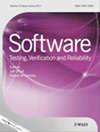一种基于集合的预测突变检测方法,考虑了未到达突变的影响
IF 1.2
4区 计算机科学
Q3 COMPUTER SCIENCE, SOFTWARE ENGINEERING
引用次数: 2
摘要
预测突变测试(PMT)是一种利用机器学习方法预测突变体是否被杀死的技术。多年来,研究人员提出了各种治疗经前症候群的方法。然而,未到达突变体对PMT的影响尚未得到充分解决。如果生成突变的语句没有被任何测试用例执行,那么突变就是未到达的。我们的目标是表明未达到的突变体可以增加PMT的结果。此外,我们提出了PMT的另一种方法,提出了PMT的不同解释。为此,我们重复了之前的PMT研究。我们对先前文献提供的654个Java项目的建议方法进行了实证评估。我们的研究结果表明,PMT的性能在接收机工作特性曲线下的面积(AUC)从0.833急剧下降到0.517。此外,PMT在27%的项目中比随机猜测表现得更差。该方法改进了PMT结果,平均AUC值为0.613。因此,我们建议研究人员在报告结果时删除未到达的突变体。本文章由计算机程序翻译,如有差异,请以英文原文为准。
An ensemble‐based predictive mutation testing approach that considers impact of unreached mutants
Predictive mutation testing (PMT) is a technique to predict whether a mutant is killed, using machine learning approaches. Researchers have proposed various methods for PMT over the years. However, the impact of unreached mutants on PMT is not fully addressed. A mutant is unreached if the statement on which the mutant is generated is not executed by any test cases. We aim at showing that unreached mutants can inflate PMT results. Moreover, we propose an alternative approach to PMT, suggesting a different interpretation for PMT. To this end, we replicated the previous PMT research. We empirically evaluated the suggested approach on 654 Java projects provided by prior literature. Our results indicate that the performance of PMT drastically decreases in terms of area under a receiver operating characteristic curve (AUC) from 0.833 to 0.517. Furthermore, PMT performs worse than random guesses on 27% of the projects. The proposed approach improves the PMT results, achieving the average AUC value of 0.613. As a result, we recommend researchers to remove unreached mutants when reporting the results.
求助全文
通过发布文献求助,成功后即可免费获取论文全文。
去求助
来源期刊

Software Testing Verification & Reliability
工程技术-计算机:软件工程
CiteScore
3.70
自引率
0.00%
发文量
34
审稿时长
>12 weeks
期刊介绍:
The journal is the premier outlet for research results on the subjects of testing, verification and reliability. Readers will find useful research on issues pertaining to building better software and evaluating it.
The journal is unique in its emphasis on theoretical foundations and applications to real-world software development. The balance of theory, empirical work, and practical applications provide readers with better techniques for testing, verifying and improving the reliability of software.
The journal targets researchers, practitioners, educators and students that have a vested interest in results generated by high-quality testing, verification and reliability modeling and evaluation of software. Topics of special interest include, but are not limited to:
-New criteria for software testing and verification
-Application of existing software testing and verification techniques to new types of software, including web applications, web services, embedded software, aspect-oriented software, and software architectures
-Model based testing
-Formal verification techniques such as model-checking
-Comparison of testing and verification techniques
-Measurement of and metrics for testing, verification and reliability
-Industrial experience with cutting edge techniques
-Descriptions and evaluations of commercial and open-source software testing tools
-Reliability modeling, measurement and application
-Testing and verification of software security
-Automated test data generation
-Process issues and methods
-Non-functional testing
 求助内容:
求助内容: 应助结果提醒方式:
应助结果提醒方式:


